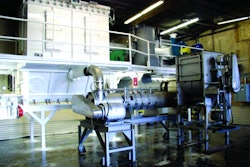
It’s been nearly seven years since the Food Safety Modernization Act (FSMA) was signed into law. While the U.S. Food & Drug Administration (FDA) has labeled FSMA as “the most sweeping reform of food, both for human and animal consumption, safety laws in more than 70 years,” many in the industry view compliance to the rules as overwhelming.
The new FSMA rules are designed to strengthen accountability for prevention throughout the entire food system — domestically and internationally. Processors of all types of food will now be required to evaluate the hazards in their operations, implement and monitor effective measures to prevent contamination, and have a plan in place to take any corrective actions that are necessary.
The next step in the law — FSMA Compliance Inspections — has arrived and your facility needs to be ready.
“FDA将进行设备检查evaluate compliance with its FSMA-related requirements,” says David Fairfield, senior vice president for Feed Services with the National Grain and Feed Association (NGFA), Arlington, VA. “Depending upon its operations, a facility in the grain and feed industry could be subject to several FSMA rules, including preventive controls for animal food, preventive controls for human food, and sanitary transportation of human and animal food.”
Grain and feed facilities are also subject to other food safety requirements established under the Federal Food Drug and Cosmetic Act (FFDCA) prior to FSMA. FDA has authority to inspect against those requirements, as well, says Fairfield.
What to prepare
Under its inspection authority, the FDA is authorized to enter any facility “in which food [is] manufactured, processed, packed, or held” and inspect “all pertinent equipment, finished and unfinished materials, containers, and labeling thereon.”
“FDA investigators have the authority to inspect facilities without a warrant to evaluate whether human food, animal feed and pet food, and grain are being stored, processed, packed and distributed in accordance with provisions of the FFDCA and its associated regulations, including those that are FSMA-related,” says Fairfield.
That means if your grain or feed facility is open for business, the FDA has the right to inspect without advanced notice.
“If your facility handles grain or feed, be prepared to undergo an inspection at any time during normal business hours,” says Perry Nettles, vice president of operations at Food Protection Services, Jonesboro, AR.
Facilities should consider developing a comprehensive plan on how to handle an inspection. The inspection plan should anticipate the scope of the inspection, questions that may be asked, and how to handle requests for copies of records and policies.
Leah Wilkinson, vice president, public policy and education, American Feed Industry Association (AFIA), Arlington, VA, says another important component is preparing an Animal Food Safety Plan.
This written food safety plan must be developed and overseen by a preventive controls qualified individual (PCQI). Wilkinson says it may require the following:
- Hazard analysis
- Required preventive controls
- Recall plan
- Procedures and the frequency with which these procedures will be conducted for monitoring the performance of the preventive controls
- Corrective action procedures
- Verification procedures and the frequency with which they will be performed
威尔金森警告说这不是一个快速的任务,所以give yourself time to prepare it correctly.
“When it comes to a feed mill, each animal you serve will have a separate portion in the food safety plan,” she says. “The AFIA has some sample plans that are up to 37 pages long.”
In addition to a food safety plan, your facility’s inspection plan should outline the responsibilities that individuals within the facility will have during the inspection.
“It’s very important to designate a person to be the ‘face’ of your facility during an inspection,” says Nettles. “If that person isn’t available, who is the number two person that will take charge?”
Each facility is required to have a PCQI in place. This person must be properly trained to identify and address potential hazards.
The PCQI should be able to “speak intelligently” about the facility’s food safety plan, says Kim B. Koch, PhD, Feed Center Manager, Northern Crops Institute at North Dakota State University (NDSU), Fargo, ND.
“All qualified individuals should receive animal food safety training and make sure that training documented in the food safety plan,” says Koch.
Keep in mind, the FSMA animal food rule has two distinct definitions for a “qualified individual” and a PCQI, says Fairfield. They are not the same.
“For facilities subject to the rule, all individuals that manufacture/process, pack or hold food at the facility are to receive documented training on how to perform their duties in a manner that assures food safety,” he says.
Steps of the inspection
When an FDA investigator arrives at your facility, he or she should present a badge and credentials and a Notice of Inspection – Form FDA 482 upon arrival.
“While presenting the Notice of Inspection, the investigator should state the purpose of the visit and/or inspection,” says Fairfield. “This information should help the facility understand the scope of the inspection.”
Wilkinson notes, however, that the FDA is not required to provide the reason for the inspection. She also says the length of the inspection will vary depending on the facility and purpose.
“There are up to four different inspection types,” she explains. “For example, a feed mill with medicated feed will differ from a grain processing facility. It could take three to four hours or three to four days.”
FSMA-related surveillance inspections to evaluate compliance with the current good manufacturing practice requirements for animal food typically have lasted one to two days. It’s anticipated that inspections to evaluate compliance with the preventive controls requirements for animal food could last three to four days.
After an opening discussion with facility personnel, FDA investigators’ typically will want to tour the facility to observe its operations and conditions.
FDA investigators have authority to obtain samples during the inspection.
Nettles says the primary focus of the inspection will be sanitation, pest control, quality control of product and record keeping.
“Do you have a cleaning frequency?” he asks. “Are you doing what you say you’re doing? Do you have the training and documentation to back that up?”
Pest management questions will revolve around your approved pesticide list, outsourced or in-house, and application records for all insecticides and rodenticides.
As they tour, Nettles says they will ask questions about your facility and operations. Having a trained PCQI individual in place is necessary.
When it comes to grain quality, inspectors will focus on the steps the facility has taken to ensure quality upon receipt and during storage. This will include initial sampling, initial testing, periodic inspections and temperature/moisture monitoring.
Remember, the FDA is concerned about food safety issues, which are not the same as food quality issues. For grain, mycotoxins will be a focus. Grain facilities should be aware of FDA’s regulatory guidance related to mycotoxins and have storage practices in place to minimize the potential for mycotoxin levels to increase.
“Other questions may range from the types of commodities you store, how you transport — is it interstate or intrastate — who’s your parent company and other general information,” says Nettles. “If you have more than one person designated as the trained competent person, then everyone needs to be trained the same way and on the same page.”
After the tour, the investigator will focus on evaluating compliance with specific requirements related to the purpose of the inspection.
“In general, FSMA-related compliance inspections will focus on the practices and procedures the facility has in place to ensure that the safety of food products that it handles,” says Fairfield.
Record keeping
How important is record keeping under FSMA? It’s vital, say sources.
“All of the FSMA rules have provisions that specifically require certain records to be established and maintained,” says Fairfield. “FDA has the right to access, review and copy any required record. Having all required records in place is essential for a facility to demonstrate compliance.”
Each FSMA rule specifies what records are required to be established and how long they are to be kept. Some examples of records required by the preventive controls for animal food rule are those related to qualified individual training, a written food safety plan, including written hazard analysis, and, as appropriate, written preventive controls and a recall plan.
“Keeping records is very important,” says Koch. “If it’s not written down, it didn’t happen.”
While the FDA has the right to access, review and copy any record required under its regulations, in some cases, it may request documentation for which it does not have clear authority to access. Facilities should have a written policy that designates those records the investigator will be allowed to access and copy, if requested.
- Records that may be involved in an inspection can include:
- Inbound and outbound bills of ladings
- Grain mycotoxin testing results
- Testing equipment
- procedures and calibration
- Employee and contractor training
- Pest management records
The best advice sources had to give with regards to FSMA inspections: Be prepared.
“Know what’s required,” says Fairfield. “Develop programs and practices that demonstrate compliance and have an inspection plan in place.”
Wilkinson agrees. “Know the rules,” she says. “Know your requirements and be ready to comply. That’s the best advice I can give.” ■
What happens if you get an infraction?
FDA uses a Form FDA 483 — Inspectional Observations — to document what the investigator believes are objectionable matters that were observed during an inspection.
While there is no legal obligation for the facility to formally respond to a Form FDA-483, it may be beneficial to do so.
In this regard, FDA has established a policy that allows 15 days for companies to respond in writing to the agency after issuance of an observation on Form FDA-483. The company’s written response must be received by FDA in the allotted time period if the company wishes to have its comments considered when FDA determines whether to initiate enforcement action based upon the observations.
If FDA believes it is warranted based upon the inspection findings, the agency may issue a “Warning Letter” to the facility. FDA uses Warning Letters for violations that may lead to enforcement action if they are not corrected promptly and adequately. For any Warning Letter received, the facility should provide a response back to FDA within the specified timeframe on how it intends to address the alleged violation(s).
Facilities should take FDA’s documented observations seriously and always follow through on actions that it indicates to FDA will be taken to remedy non-compliant conditions. Otherwise, depending upon the significance of the non-compliant condition, FDA may initiate further enforcement actions, such as seizures, injunctions or consent decrees.
Source: David Fairfield, National Grain and Feed Association






















